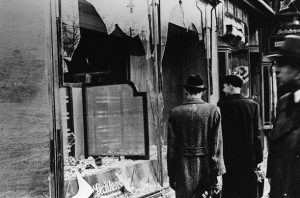The Holocaust

Broken Shop Window, Kristallnacht, Nov. 10, 1938
While the Nazis devised and implemented the final solution, they also needed to control existing Jewish communities. Beginning in 1939, Nazis quarantined Jews into ghettos, located in large Polish cities like Warsaw and Lodz, where a Jewish Council (Judenrat), established by the Nazis but staffed by Jews, was responsible for transmitting and enforcing Nazi decrees.
Various forms of Jewish resistance existed in the ghettos and the camps, including armed revolts and more subtle, culturally-based, forms of defiance, like writing cookbooks and celebrating Jewish holidays.
This systematic, bureaucratic, state-sponsored persecution and attempted annihilation of European Jewry by the Nazi regime and its collaborators between 1933 and 1945–in which approximately six million Jews were killed–is known as the Holocaust.
Excerpted from The Story: 1914-1948, MyJewishLearning.com.
Primary Sources
- Nuremberg Laws on German Citizenship, 1935.
- Kristallnacht, Nov. 9-10, 1938
- Telegram from Reinhard Heydrich to the Offices of the Security Services, Nov. 8, 1939.
- Eyewitness Account of Kristellnacht by a Firefighter
- Decisions Taken at the Evian Conference On Jewish Refugees, July 14, 1938.
- Discussions by the Authorities Following Kristallnacht, November 12, 1938.
- Report of the American Consul in Stuttgart to the State Department Regarding Crystal Night in Stuttgart, November 15, 1938.
- Jewish Woman Complains of Money Stolen on Kristallnacht, November 24, 1938.
- Palestine- Statement of Policy (Cmd. 6019) – May 1939- Important Points
- Treaty of Nonaggression Between Germany and the Union of Soviet Socialist Republics, Aug. 23, 1939.
- The Mufti’s Diary Entry on His Meeting with Hitler, Nov. 21, 1941.
- The German “Final Solution,” 1941.
- The Warsaw Ghetto Uprising- Telegram from Yitzhak Schwartzbart to the Jewish Agency, Aug. 8, 1943.
- Prayer for Eating Hametz in Concentration Camp, 1944.
- International Response to Hitler’s Rise to Power and the Holocaust
- Anne Frank
Newspaper Articles
- For a Diplomat’s Murder Nazi Germany Takes an Awful Revenge on its Jews, Life Magazine, Nov. 28, 1938.
- Nazis Smash, Loot and Burn Jewish Shops and Temples Until Goebbles Calls Halt, NY Times, Nov. 11, 1938.
- Volkischer Beobachter, Nov. 11, 1938.
- Herr Hitler plans new steps against Jews, The Telegraph, Nov. 12, 1938.
Images
- Burning of the Michelsberg Synagogue, Nov. 10, 1938
- Burning of the Kuppenheim Synagogue, Nov. 10, 1938
- Broken Shop Window, Nov. 10, 1938
- The Essenweinstrasse Synagogue, Nov. 10, 1938
- Furnishings of the Zeven Synagogue Dumped in the Town Square, Nov. 10, 1938
- The Burned-out Synagogue of Aachen, Nov. 10, 1938
- Tax Assessment for Damages from Kristallnacht, Dec. 19, 1938
- Postcard of Adolf Hitler and the Mufti of Jerusalem Meeting in Berlin
- The Mufti Reviewing Bosnian Troops, Jan. 12, 1944.
- The Mufti, Giving the Nazi Salute, Reviewing Moslem SS Troops.
- The Mufti with Bosnian Volunteers of the Waffen SS
- Aerial Photograph of Auschwitz, Apr. 4, 1944.
- Photographs from Our Destruction in Pictures, Bergen-Belsen, Dec. 1946.
- Stamp Commemorating Kristallnacht, Germany, Nov 9, 1963.
Videos
Websites
- Anne Frank House
- Alan M. Dershowitz- Ahmadinejad’s Holocaust Myths
- Holocaust Education & Archive Research Team
- The Mufti and the Führer Click here for more on The Mufti of Jerusalem and Yasser Arafat.
- Nazi and East German Propaganda Page
- United States Holocaust Memorial Museum
- Yad Vashem- The Holocaust Martyrs’ and Heroes’ Remembrance Authority
- The Holocaust History Project
- The Holocaust Project
- The Nazi Olympics- Berlin 1936
- The Evian Conference
- Yad Vashem- Kristallnacht
Further Reading
What do you want to know?
Ask our AI widget and get answers from this website